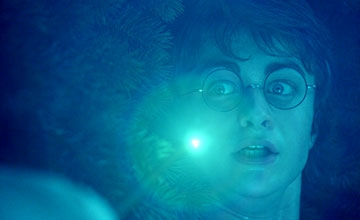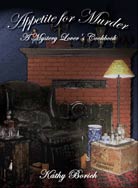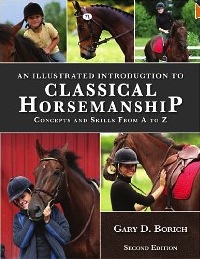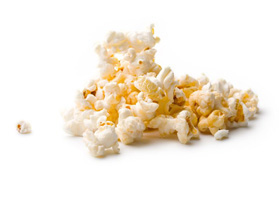Harry Potter and the Goblet of Fire: Blueberry Goblet of Fire
Year Released: 2005
Directed by: Mike Newell
Starring: Daniel Radcliffe. Emma Watson, Rupert Grint, Michael Gambon, Brendan Gleeson, Robbie Coltrane
(PG-13, 157 min.)

"Fire is the test of gold; adversity, of strong men." Seneca
Harry Potter and the Goblet of Fire is a smorgasbord of a film filled to the brim with old favorites and new delights. The splendid Hogwarts School sparkles with medieval majesty and mayhem, the eccentric professors inspire awe, that piquant dish of wonder peppered with dread, while tried friends and old enemies test the murky waters of adolescence.
But like a plate overflowing with self selected delicacies, sometimes the gravy spills over onto the dessert and we are left with a mishmash of tastes that strangely fails to satisfy, leaving us to wonder if we might have been better off ordering from the menu.
The film seamlessly winds together three plots – the Triwizard Tournament, a Homeric trial of courage and skill that pits fourteen-year-old Harry against three older and more seasoned rivals, the awkward anguish of a Christmas Ball, which for some is a more tortured affair that the fire-breathing dragons from the tournament, and the distant rumblings of the evil Lord Voldemort, who plots his malevolent return to power.
The old favorites are there but seem to take a back seat to the flourish of new arrivals who swoop down in an airborne carriage pulled by magnificent winged steeds or emerge from the deep waters of Hogwarts’ lagoon in an ancient Windjammer. These exchange students are from two other schools of the ancient arts, the Beauxbatons Academy from France, and the Durmstrang School from Central Europe.
Clad in crisp blue uniforms, the French maids make their entrance into the grand dining hall like a string of fresh-faced majorettes lighting up the high school football stadium on a Friday night. Their star, Fleur Delacour (Clemence Poesy) will represent her school in the Triwizard Tournament, and is as courageous as she is beautiful. The Durmstrang boys, a bit of a word play on the German Sturm und Drang, “Storm and Stress” boasts Victor Krum (Stanlislav Zaneski), the heart throb boy wonder who has already awed the Magic world with his mastery of Quidditch, something like aerial soccer played by wand riding wizards. Rowlings, perhaps in a tongue and cheek salute to her countrymen, has imbued him with a thick skull and vague menace reminiscent of Britain’s World War II view of their German neighbors. Representing Hogwarts, is Cedric Diggory, handsome and noble in true RAF tradition.
The Headmistress of Beauxbaton is Madame Maxine (Frances de la Tour), a statuesque Olive Oil to Hagrid’s (Robbie Coltrane) Pop-Eye. She bats her eyes at him and he even takes to combing his hair. Also new is Alastor “Mad-Eye” Moody, new Professor of Defense Against the Dark Arts, played with Dickens-like blend of macabre charm by Brendan Gleeson. He opens class with a demonstration of the three forbidden spells (loss of self-will, torture, and death) foisted upon a very unwilling large insect, who climbs aboard terrified young wizards prior to writhing in agony before them, and finally succumbing to its own mortality. Not a bad way to preempt any class discipline problems!
But with all these new characters, there isn’t much time or room for the old favorites to do much but linger in the background. Maggie Smith as Professor Minerva McGonagall is splendid as she instructs a mortified Weasley (Rupert Grint) in the art of ballroom dancing in front of the entire class. But that is about all we see of her. I also missed Professor Severus Snape (Alan Rickman) who seemed permanently poised on the brink that separates good from evil in the earlier two films. All he is allowed to do in this installment is to whine over potions missing from the dark recesses of his laboratory. And I liked Hagrid more when he was uncouth, with a tangled mane, and on the edge of morphing into the incredible Hulk rather than the tame servant of love he plays here.
Ron Weasley feuds with Harry over some imagined injustice and whines his way through most of the film, never rising to the reluctant aide de camp he usually plays. Hermione (Emma Watson) is also underused in this installment; her ready wit, academic prowess, and fair-minded ministrations do not shine through as strongly. Instead she is a rather passive beauty, a fragile flower unfolding who shocks everyone when she arrives Cinderella like at the ball on the arm of Victor Krum.
Certainly there is the eye candy of special effects – fire-breathing dragons, the actual goblet of fire glowing with a blue flame, golden eggs that shriek and only reluctantly divulge their secrets, malicious mermaids, and a fully fleshed Lord Voldemort played with grotesque glory by the superb Ralph Fiennes – more than enough to buck up the box offices and provide a holiday sized portion of vicarious thrills and chills.
Although lauded by most critics as the best of the four and hailed by Hollywood for breathing new life into the movie going public, Harry Potter and the Goblet of Fire is an entertaining but somewhat disappointing spectacle. Like the Macy’s Thanksgiving parade, its fine cast floats by us in an amazing procession of overreaching splendor, a moment of transitory glory before the camera’s eye, but it is a parade only, driven by entertaining vignettes that never really coalesce into a unified plot.
—Kathy Borich
Film-Loving Foodie
The commanding presence in today’s feature is, of course, the goblet of fire, a magical chalice that sports blue flames and an imperious nature. Even though Harry, at age 14, is below the 17 year-old age requirement for the Triwizard Tournament, when his name is belched forth from the magical goblet, no one, not even Dumbledore, disputes it.
To end your evening on a similar note of magic, I have taken a recipe for Cherries Jubilee and substituted blueberries for the cherries to ensure the requisite blue glow. This dish is as simple as it is elegant and dramatic, a perfect dessert for the culinary adventures of the Christmas season.
Bon Appetit!
Blueberry Goblet of Fire
“The term flambé [flahm-BAY] is a French word meaning "flaming" or "flamed." Flambé means to ignite foods that have liquor or liqueur added. This is done for a dramatic effect and to develop a rich flavor of the liqueur to the foods without adding the alcohol.
Please remember to use extreme caution here, you will be dealing with a liquid that is on fire; do not carry the dish while flaming, this is best done on a serving cart slightly away from your table. Keep a large metal lid on hand, to cover the dish in case your flambé gets out of hand.
Use a brandy or 80-proof liquor or liqueur. Liquors that are higher proof are too volatile when lit. Choose liquors or liqueurs that are complimentary to the food being cooked, such as fruit flavored brandies for fruits and desserts and whiskey or cognac for meats.
Heat the brandy or liquor in a saucepan, with high sides, just until bubbles begin to form around the edges. The boiling point of alcohol is 175 degrees F. (much lower than water). The liquor can also be heated in a microwave oven by heating 30 to 45 seconds in a microwave-proof dish at 100 percent power.
Use a flambé pan with rounded, deep sides and a long handle. Never pour liquor from a bottle into a pan that is near an open flame (the flame can follow the stream of alcohol into the bottle and cause it to explode). NOTE: If the dish doesn't light, it's probably not hot enough. The food to be flambéed must also be warm. Cold foods may cool down the warm liquor where it will not light.
Once you add the liquor to the pan, do not delay lighting. You don't want the food to absorb the raw alcohol and retain a harsh flavor. Ignite with a long match (such as fireplace matches or a long barbecue lighter). Always ignite the fumes at the edge of the pan and not the liquid itself. Never lean over the dish or pan as you light the fumes.
Let cook until flame disappears (at this point all alcohol has burned off). If you want to retain some of the alcohol flavor, cover flaming dish to extinguish flames or add additional wine or stock.
Serve the dish as soon as the flame disappears.
HINTS: If you want the flames, but do not want the liquor in a dessert, soak sugar cubes in a flavored extract. Place the cubes around the perimeter of the dish and light.”
- 1 can (16-ounce) blueberry pie filling
- 1/2 cup brandy
- Good quality vanilla ice cream
In a small saucepan over medium heat, heat blueberries. In another small saucepan, heat brandy (it won't flame unless it is heated).
Spoon ice cream into goblets and spoon heated cherries over ice cream. Pour heated brandy over the warm cherries and ignite.
Makes 4 to 6 servings.
Recipe Source: whatscookingamerica.net



 Classic & Crime
Classic & Crime